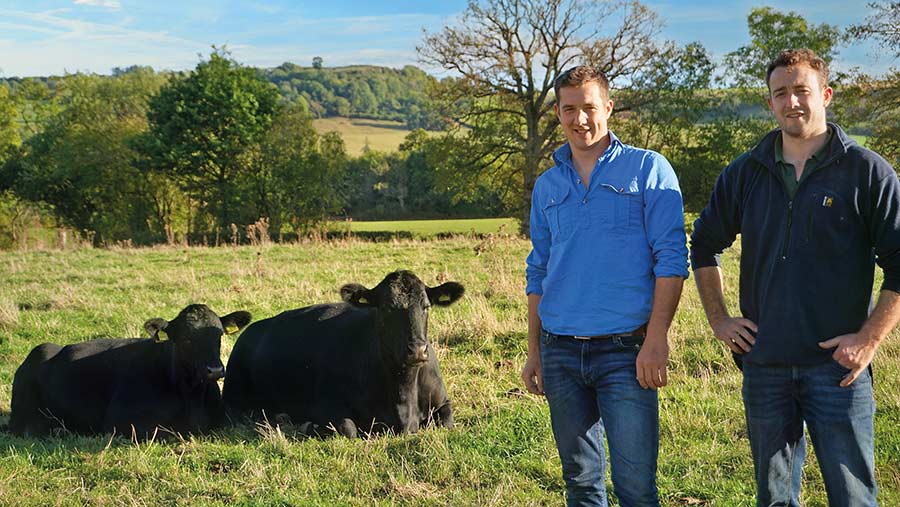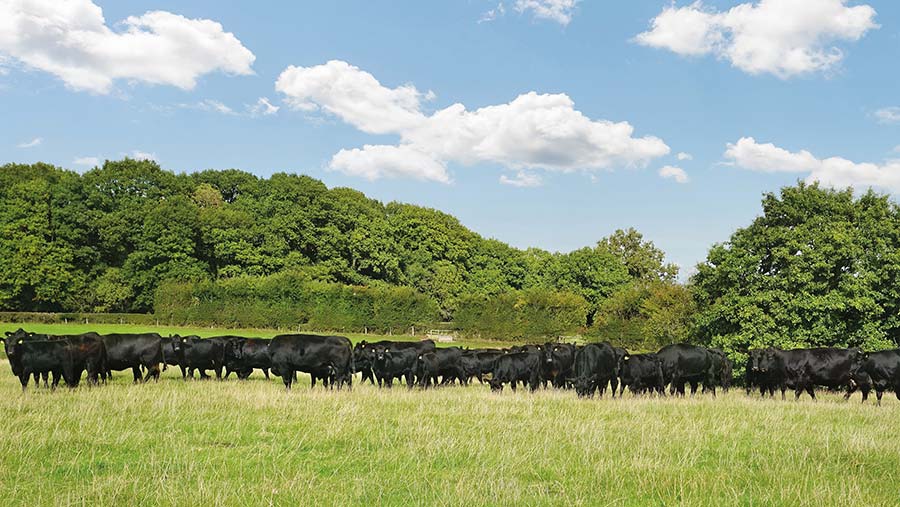Radical change to farming system comes with switch to pedigree beef
 Harry and George Gilbert © Harry Gilbert
Harry and George Gilbert © Harry Gilbert A desire to improve animal health drove the Gilbert family to radically change their farming system.
Before 2018, the family kept a mix of breeds – Limousin-cross, Salers-cross, Blue-cross and Simmental-cross – with everything mated to Charolais and Limousin bulls.
However, when they started testing for Johne’s and bovine viral diarrhoea (BVD), it led them to question their system, says Harry Gilbert.
See also: How pedigree breeds have changed in each sector
Harry farms with his brother, George, alongside their father, Nick, and uncle, Phil, at Nantyglasdwr Farms near Hay-on-Wye.
At first, the family decided to address the problem by culling problem cows and buying replacements.
However, they struggled to find any high-health commercial farms where they could purchase replacements.
They decided to move to a pedigree, closed herd of cattle to help them achieve their desired high-health herd status.
Along the way, they have also created a system that was easier to manage and less intensive.
Farm Facts
- 220ha (543acre) farm with 60 pedigree Aberdeen Angus cattle, 1,000 Suffolk cross Mules and Hardy Speckled ewes, and 80ha (198 acres) of cropping
- Fourth-generation tenant farmers
- Lambs from lowland ewes are sold finished at local markets
- Lambs from Speckled ewes are sold as stores
- Breeding stock sold
- Finished beef sold to ABP and local butchers
Switching breeds
They now run a 60-cow pedigree herd of Aberdeen Angus cattle, under the Harewood prefix, as part of a mixed livestock and arable enterprise at the 220ha (543-acre) farm.
“We wanted a cow that would look after herself, calve unassisted but also produce high-quality animals for today’s market,” explains Mr Gilbert.
The Gilberts started their Aberdeen Angus herd with the purchase of 12 maiden heifers from Rosemead and six from Dark Lane in 2018.
Mr Gilbert admits the purchase was a “bit of an experiment”, with the heifers artificially inseminated to the Australian bull Millah Murrah Klooney K42 before being swept with a Limousin bull to calve at two years old in the spring of 2019.

Harewood Jack © Harry Gilbert
But the family were so impressed with the Aberdeen Angus progeny that a further 10 maiden heifers were bought from Dark Lane in 2019, alongside a bull from the Oakchurch herd, and all of the commercial cattle were sold.
“Straight away, we noticed a massive difference in calving ease and with the quietness of the cows. The vigour of the calves also stood out massively. We pretty much fell in love with them straight away,” says Mr Gilbert.
Their home-bred stock bull – Harewood Jack V694, by Millah Murrah Klooney K42 – is leaving an impressive mark on the herd.
“We don’t want a massive cow, just one with a moderate frame that’s milky, fertile, and has a quiet temperament.”
Change in focus
The introduction of Aberdeen Angus cattle to Nantyglasdwr Farms didn’t just mark a change in breeds, but also a shift in focus for the farm’s beef enterprise.
All bulls were previously kept entire, finished at 15-16 months, and sent to ABP, with heifers finished at 18-20 months and sold to ABP or local butchers’ shops.
The focus is now on producing breeding stock, and anything not suitable for breeding is finished on the farm, with bulls going to ABP and all finished heifers sold to the local butcher.
Less-intensive management
The family had grown to dread calving their old cattle as they often had to assist cows or tube-feed calves in the middle of the night.
The move to Aberdeen Angus cattle has not only reduced the need for intervention, but also cut input costs.
Cows calve indoors over eight weeks from 1 February to the end of March, when they will be turned out to grass until December.
“Harewood Jack V694 had 30 cows in-calf in 2022 and they all calved unassisted, apart from one that was coming backward, and his calves averaged 34kg birthweight for 24-month-old heifers and 39kg for cows,” says Mr Gilbert.
From a financial perspective, he says the Aberdeen Angus cattle require much less feeding than the farm’s continental-cross cows did in the past.
Heifers and bulls for finishing are housed in October and fed a ration of silage and hay or straw, alongside a homegrown mix of peas, wheat, barley and oats.
The bulls remain inside until finishing, but the heifers graze for a second season from April/May and will be finished on grass.

© Harry Gilbert
“When we bought those first 18 heifers, I did a bit of a trial on them that winter.
“Just on feed alone, they cost us about £2,000 less to keep during the winter housing period, in comparison with 18 of our continental cows, primarily because they were on straw rather than good-quality silage.
“One thing we’ve noticed with the Aberdeen Angus is that they stay fit – our heifers were still fit in the winter on just limited silage and straw.”
Future plans
In the future, the Gilberts hope to increase the size of the Harewood herd to between 80 and 100 cows.
“I think with the challenges that the farming industry is facing with ever-rising input costs, the less intensive Aberdeen Angus cow can only be for the better, as they still have the ability to thrive with substantially fewer inputs,” adds Mr Gilbert.
Key figures
- 20: Number of breeding bulls sold in two years
- £111.11: Cost saving a head over the winter housing period after switching to Aberdeen Angus from continental-cross cows – based on £2,000 saving for 18 animals
- 34kg: Average birthweight of calves from heifers and 39kg for calves from cows
